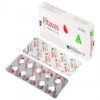Description:
Indications
Pitavastatin is used in adult patients with primary hyperlipidemia or mixed dyslipidemia as an adjuvant therapy to diet to lower total cholesterol (TC), low-density lipoprotein cholesterol (LDL-C), apolipoprotein B (Apo B), triglycerides (TG), and enhance HDL-C.
Pharmacology
Pitavastatin reduces plasma cholesterol and lipoprotein levels via blocking HMG-CoA reductase and cholesterol synthesis in the liver, as well as increasing the number of hepatic LDL receptors on the cell surface, resulting in improved LDL uptake and catabolism.
Dosage & Administration
The dose range for Pitavastatin is 1 to 4 mg orally once daily at any time of the day with or without food. The recommended starting dose is 2 mg and the maximum dose is 4 mg. After initiation or upon titration of Pitavastatin, lipid levels should be analyzed after 4 weeks and the dosage adjusted accordingly.
Dosage in Patients with Renal Impairment: Patients with moderate renal impairment and end?stage renal disease receiving hemodialysis should receive a starting dose of Pitavastatin 1 mg once daily and a maximum dose of Pitavastatin 2 mg once daily. Pitavastatin should not be used in patients with severe renal impairment.
Interaction
Pitavastatin and cyclosporine should never be taken together.
Pitavastatin exposure was considerably boosted by erythromycin. Pitavastatin 1 mg once daily should not be exceeded in persons taking erythromycin.
Rifampin: Rifampin raised Pitavastatin exposure substantially. Pitavastatin 2 mg once daily should not be exceeded in people receiving rifampin.
Pitavastatin should be used with caution if gemfibrozil or other fibrates are taken at the same time.
Contraindications
Patients who have a known hypersensitivity to any of the product’s ingredients. Pitavastatin has been linked to hypersensitivity events such as rash, pruritus, and urticaria. Patients with active liver disease, as evidenced by unexplained prolonged hepatic transaminase increases.
Side Effects
Rhabdomyolysis, myopathy and Liver enzyme abnormalities.
Pregnancy & Lactation
X is the pregnancy category. Pitavastatin should not be taken by women who are pregnant or may become pregnant. Although it is unknown whether Pitavastatin is excreted in human milk, a small quantity of another medicine in this class has been demonstrated to enter into human milk.
Precautions & Warnings
Pitavastatin should be used with caution in people who have myopathy risk factors. These variables include advanced age (>65 years), renal impairment, and hypothyroidism that has not been appropriately managed. HMG-CoA reductase inhibitors, such as Pitavastatin, have been linked to an increase in serum transaminases. The increases were usually temporary and resolved or improved with continuous therapy or after a brief break from therapy.
Storage Conditions
Keep in cool and dry place and away from light. Keep away from children







Reviews
There are no reviews yet.